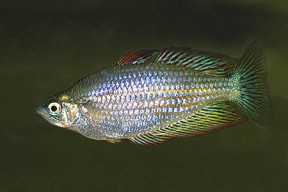Melanotaenia splendida splendida
Eastern Rainbowfish
Classification
Melanotaeniidae
Distribution
Australia.
Habitat
Found across a variety of habitats, including swamps, lagoons, streams and rivers. Most of these biotopes are subject to seasonal changes in temperature, water level and dissolved sediment. The fish are typically found under cover of aquatic vegetation or other debris, such as submerged logs.
Maximum Standard Length
6″ (15cm).
Aquarium SizeTop ↑
An active species requiring an aquarium measuring at least 48″ x 12″ x 12″ (120cm x 30cm x 30cm) – 110 litres.
Maintenance
This species, like most rainbows, looks most at home in a planted aquarium. Provide areas of dense vegetation, along with some open areas for swimming. Water movement can be slow to moderate, although live plants usually prefer little to none.
Water Conditions
Temperature: 68-86°F (20-30°C) in nature due to seasonal changes. A temperature of 77-82°F should suffice in the aquarium.
pH: Aim for somewhere around neutral. The pH of the fishes natural waters varies wildly from 5.0-8.0.
Hardness: 5-20°H
Diet
Unfussy and will accept most dried, frozen and live foods. Regular feedings of the latter will ensure the best colouration.
Behaviour and CompatibilityTop ↑
Very peaceful but can disturb smaller or slow-moving fish with its rapid movements and relatively large size. Good tankmates include other similarly-sized rainbowfish, characins, danios, barbs, freshwater gobies and catfish such as Corydoras.
This rainbowfish can be quite skittish and does far better when kept in a shoal of at least 6-8, preferably more. The males will also be encouraged to display their best colours in the company of conspecifics. Obviously, a suitably-sized aquarium would be required for a very large group.
Sexual Dimorphism
Mature males are larger and exhibit brighter colouration than females. They also develop a much deeper body than females as they grow, and develop longer dorsal and anal fins.
Reproduction
As with other members of the genus, this is not a difficult species to breed, being an egg scatterer, although the fry can prove somewhat tricky to raise. The breeding aquarium should be at least 30″ long, and contain slightly hard, alkaline water with a pH of around 7.5 and a temperature of 80-84°F. A small air-powered filter will provide sufficient oxygenation and flow. The tank should be filled with fine-leaved plants such as java moss, or nylon spawning mops. No substrate is necessary.
The adult fish are best conditioned in a group in a separate aquarium, with plenty of live and frozen foods. As the fish come into condition, the females will appear noticeably plumper, and males will display to each other almost constantly. Select the fattest, best-coloured pair for spawning and introduce them to the spawning tank. A small raise in temperature can often induce spawning. The pair will spawn for a period of several weeks, laying batches of eggs each day. These are attached to surfaces by a small thread. Although the adults tend not to eat the spawn, it’s easier to raise the fry in a separate aquarium, so we recommend checking the plants or mops regularly and removing any eggs you find to a raising tank containing water from the spawning tank.
The eggs hatch in 7-12 days, depending on temperature, and the tiny fry initially require infusoria–type food, before graduating onto free swimming foods, such as brine shrimp nauplii, after a week or so. Sinking foods are unsuitable as the fry tend to stay very close to the water surface.
NotesTop ↑
There are currently 4 described subspecies of Melanotaenia splendida. The principle differences are generally in colour, pattern and fin counts, although even these vary depending on the locality of the fish. M s. splendida in particular also exhibits a wide variation in colour and patterning depending on locality within the subspecies, and the species name is often suffixed with a place name when the fish are seen for sale. The different forms and subspecies should not be mixed in the aquarium, as they may hybridise. As with many other rainbowfish, adult specimens are rarely seen for sale, and it’s the much drabber juvenile fish that are almost always offered in dealers tanks. However exercise some patience (even on a good diet, full colour development can take over 12 months), and you will be rewarded with a truly gorgeous adult fish.


